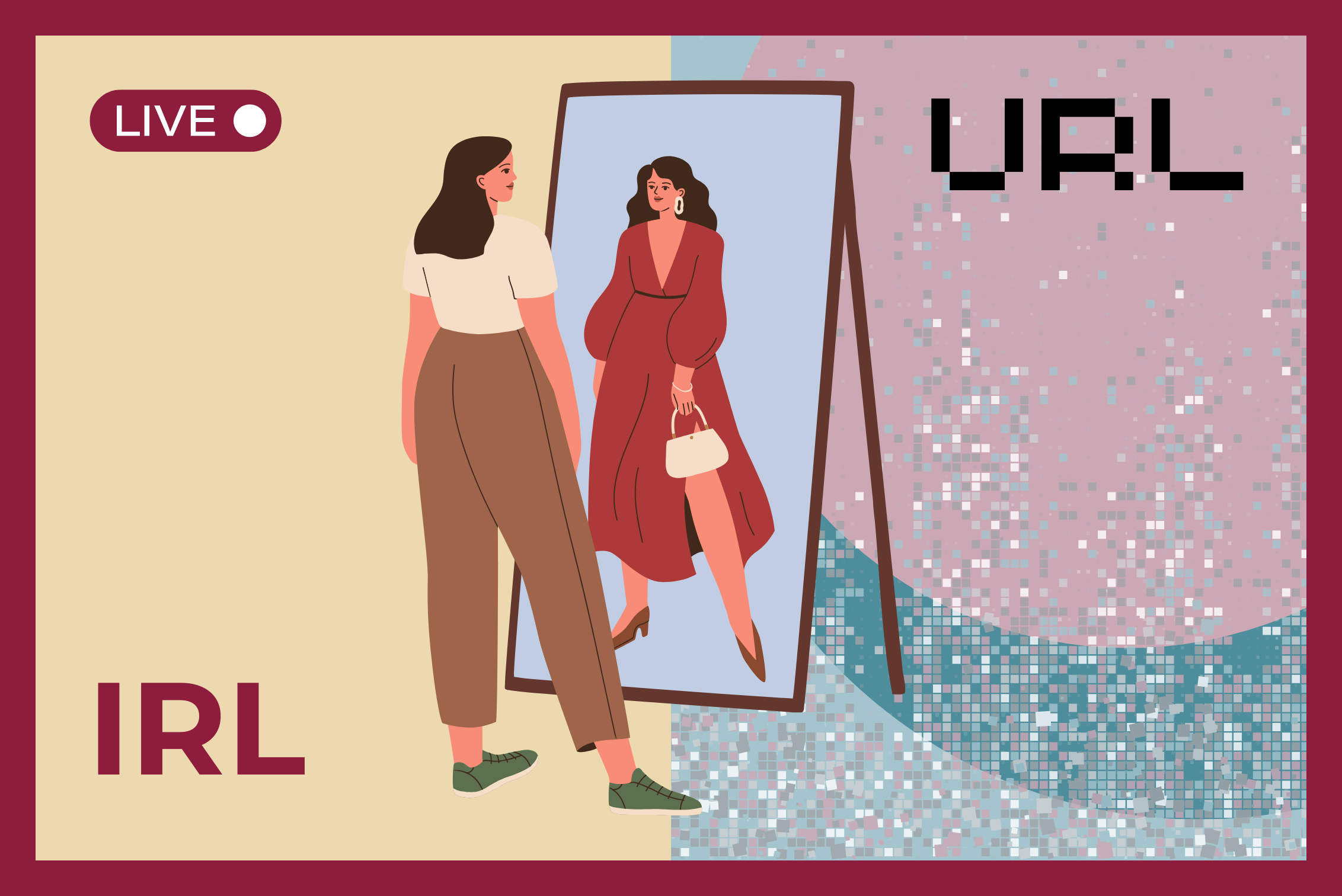IRL vs URL: Why the Split is Costing You Jobs
By: Judy Cohen
This piece comes out of a string of conversations I had at the latest International Citizens Day in Copenhagen. More than a few people commented on my “bold” and “authentic” LinkedIn presence… when in reality, it’s mostly me ranting about some linguistic or educational trend, or trying to jailbreak the latest AI (or the people using it).
That gap between how others see us online and how we show up in real life stuck with me... and it’s exactly what this article is about.
The internet promised connection. What it delivered, most of the time, is performance.
We all know someone who sparkles in person but flattens online.
Or the opposite… Bold and funny on social, then awkward as a buffering Zoom call in real life.
Platforms don’t help:
LinkedIn wants polish, Instagram wants pretty, and Twitter (or whatever it’s called this week) wants punch.
With your boss, grandma, and crush all watching, most people default to the blandest, safest version of themselves.
That’s how the quirky illustrator ends up posting beige motivational quotes.
The charismatic speaker becomes LinkedIn’s 45th “thought leader” of the day. The Friday-bar star shows up online as a navy-blue corporate avatar.
What we end up with is a double life. URL-you are smooth, cropped, edited. IRL-you still drop coffee, swear at Excel, and make people laugh. If those two feel like strangers, trust cracks.
The split creates a whiplash. One version online, one in real life. If they don’t overlap enough, recruiters, managers, and colleagues start asking which one is real... and that question alone can cost opportunities.
The Gap
Why do we show up one way online and another in real life?
Because online you get a backspace. In person, your bad joke just sits there, dying in the air.
Because the platforms hand out costumes: LinkedIn wants you in a blazer, Instagram wants you holding a latte, Twitter wants you yelling opinions like a street preacher.
Because one post has a hundred audiences... boss, grandma, ex, random recruiter... so you play it safe, or post something so bland it dissolves on contact.
And then there’s disinhibition. Behind a screen, some people swing the other way, louder, sharper, harsher than they’d ever be in a real office. That’s how you get LinkedIn rants in all caps or “quirky” tweets that would never survive a Monday-morning team meeting.
It’s not lying, it’s survival. But when the character you play online drifts too far from the person you are offline, that’s when the trouble starts.
When the Split Shows Up at Work
Here’s the thing... recruiters notice.
If your LinkedIn reads like you secretly run half of McKinsey but you show up to the interview mumbling through your own name, they feel it.
If you’re magnetic in a coffee chat but have no online presence (in a role that actually expects one), you don’t even get the invite. That’s the recruiter whiplash.
They’re not mad, they’re just confused... and recruiters are people too (so far). Inconsistency throws them off, and well... confusion rarely ends with a hire.
Then there’s trust. Employers aren’t scrolling your posts because they’re nosy, they’re checking for consistency. Who are you when no one’s editing? If your URL and IRL don’t line up, alarms go off… And once doubt walks into the room, you’re already in the wrong pile.
The wrong fit is another hidden cost.
Play it too safe online, and you attract jobs made for your beige twin instead of you.
The humor, the spark, the edge that makes people remember you... gone. Six months later, you’re staring at the ceiling wondering why you’re not hired yet, while your beige twin is sitting in the job you should have had.
And don’t underestimate masking fatigue.
Running two personas, one online, one offline, is like keeping two browsers open, each with twenty tabs. Our brains weren’t built for that kind of constant switching.
The cognitive lag is real... and eventually the whole system freezes, leaving you stuck rebooting.
Finally, missed chances. People remember humans. The candidate who posts a mix of process, personality, and reality is the one who sticks. The one who plays it too safe turns into wallpaper. And wallpaper doesn’t get hired
What This Looks Like in Real Life
Recruiters admit it... they disqualify people when the online version and the in-person version don’t match.
Every recruiter I’ve spoken to in Denmark (and abroad) says the same thing: they check LinkedIn before they even reply to an email. If URL doesn’t match IRL, they notice. And in recruitment, “notice” usually means “next.”
It shows in little ways. The “innovation guru” whose profile is all rocket emojis but in person can’t explain a single project. The motivational coach who looks incredible online, but the moment you meet him he’s as bland as drywall. The confident Friday-bar storyteller who turns into a corporate mannequin the second they write a post.
Here’s the thing: it’s ok to be yourself. If you really are a “drywall person,” own it. Or if there’s a gap between your URL and IRL selves, just know it exists and work with it. What gets people in trouble is pretending there’s no gap at all.
That mismatch doesn’t read as shy or quirky, it reads as inconsistent.
And inconsistent is risky... so recruiters move on.
Bridging the Gap
So how do you close the gap without burning yourself out?
First, keep authenticity at the core. Professional doesn’t mean personality-free. If you’re funny in meetings, let a little of that voice slip into a LinkedIn post. If you’re reflective online, bring that tone into the interview. People trust what feels consistent.
Second, flex, don’t fracture. LinkedIn isn’t Instagram, and that’s fine. Think of it like clothes: suit for work, sneakers on Saturday. Same person, different looks. The red flag is when your profiles feel like they were built for completely different humans.
Third, do an audit. Google yourself. Scroll your LinkedIn like a stranger. What story shows up in two clicks? Does it sound like the person who actually gets stuff done, cracks jokes, pulls a team across the line? If not, tweak until the same voice comes through. Not perfect, just consistent enough.
Fourth, show the spark. Don’t only post deliverables polished within an inch of their life. Share the messy draft, the lesson learned, the thing that went wrong. Perfection is wallpaper. Humans stand out.
And please, please… Stop embalming your applications. If it takes you three weeks to perfect a CV, the job is already gone. Nobody cares about the extra comma... What kills you is not applying at all.
The Mirror Test
Here’s the quick gut check.
If someone met you tomorrow, would they recognize the person they saw online? Would they hear the same voice, the same rhythm, the same spark? Or would they sit there wondering which version is real?
They don’t need to match word for word. Nobody’s LinkedIn reads like a Friday night at the bar. But they should at least feel related. Family, not strangers.
Closing Thought
Careers run on trust. And trust runs on consistency. Your URL self doesn’t have to be identical to your IRL self, but if they’re miles apart, people notice. Recruiters notice. Managers notice. Clients notice.
The goal isn’t to build the perfect persona, it’s to show up whole... online, offline, everywhere.
Because at the end of the day, the candidate who sparkles consistently will always beat the one who only sparkles on paper, or only in person.
So stop sanding off the edges. Stop over-editing. Just show up.

